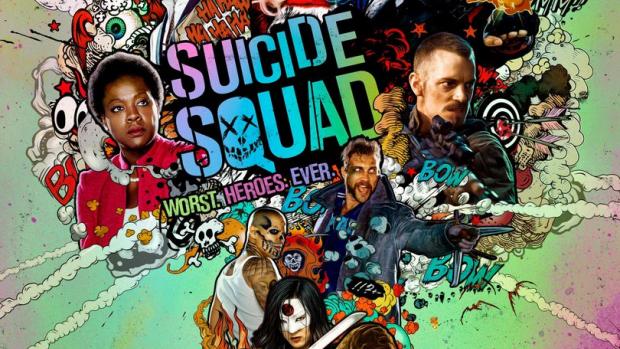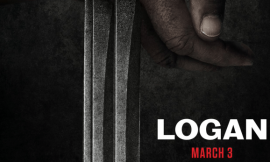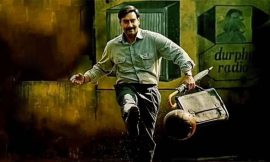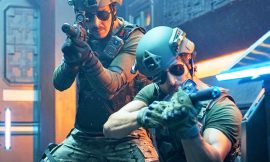Suicide Squad charges into theatres August 5th, and fans of all things DC Comics wait with baited breath to see if the universe which began with Man of Steel and Batman v Superman ascends to the same levels as the X-Men series or the Marvel Cinematic Universe. While not perfect, it still, none the less, an intriguing venture into the forthcoming DCEU which will further bloom with Wonder Woman next year. It’s also the first comic book film to focus solely on a team of villains, which opens up a new bag of possibilities in terms of character and storytelling.
As far as Suicide Squad goes, however, that bag is very mixed. The movie has issues with focus, and features a few too many characters to every really develop any of them in great depth (one great actor gets killed off early on, so much so that it’s both a waste of his skills and his character). On the other hand, it does feature some fine performances, vivid characters and some tantalizing clues about what’s to come in Justice League. Submitted for your approval and rumination—and without giving away too much of the film—please find herein 15 Reasons to See Suicide Squad.
15. AMANDA EFFING WALLER
Let’s start with the best: Amanda Effing Waller, as she shall henceforth be known. Fans of DC properties should know her well: a government agent, she distrusts and fears metahumans (DC’s term for superpowered beings) and wants to assemble a task force as a fail-safe protection. Ruthless, tough, unrelenting and fearless, she makes for one hell of a badass villain. Fans who derided the treatment of Lex Luthor in Batman v Superman should find a lot to love with the DCEU’s take on Waller.
Of course it helps that Amanda Effing Waller is played by one hell of an actress, Viola Effing Davis. Davis, like her character, knows no fear in her profession, and never tries for a moment to soften Waller’s hard edge. And here’s the best part, the part that Davis exploits in her performance to the point of utter captivation: Waller is never exactly wrong. Waller may do some horrible things, but she always has a point. Suicide Squad may not be a great comic book film, but Waller might just be the most “grey” villain since Magneto, and Davis relishes the part.
14. A RETURN TO FORM FOR WILL SMITH
Once the biggest star in the world, of late, Will Smith has fallen on harder times. The actor had a string of underperforming movies culminating with the dud After Earth, in which he appeared alongside his son Jaden. That only added to the fire—Smith met with criticism for nepotism thanks to pushing both son Jaden and daughter Willow as would-be stars. Hollywood gossip swirled around the state of his marriage, and the two-time Oscar nominee found himself snubbed for his performance in Concussion.
Lucky for Smith, he makes a welcome return to the kind of action hero character that audiences long adored him for. Smith plays the assassin Deadshot, a foe of Batman who struggles to balance his professional life with his family life. Of course, because Deadshot kills people for a living, his relationship with his young daughter suffers. Smith turns on the charisma and gives an impressive physical performance while still injecting Deadshot with pathos. Smug, regretful and remorseless, he, like Amanda Effing Waller, becomes a sort of anti-hero, at once both sympathetic and loathsome. It’s a fine performance, and at least somewhat redeems Smith for his less-than-enjoyable outings.
13. HARLEY QUINN
Longtime DC fans should also celebrate the big screen’s first Harley Quinn, played with zest by Margot Robbie. A true bombshell, Robbie is a wonder to behold, and clearly has a ball playing the Clown Princess of Crime. Flexing, bending and acrobatic, Robbie, like Smith, performs some impressive physical feats over the course of the film. Her blond tresses and blue eyes also give her the right look for the character: it’s hard to imagine another actress looking the part so well.
Anxious DC readers will also enjoy Harley’s backstory: as in the comics, she once worked as a great psychiatrist at Arkham Asylum (which does have a brief cameo itself). She made the mistake of falling in love with the Joker, and the two begin a bizarre, sadomasochistic relationship. Unlike some of the comics, however, Robbie’s Harley isn’t just forced to become a lunatic murderess. Instead, she makes choices which give a new dimension to her character. Though crazy and violent, Harley still has a moral compass, even if a horribly skewed one.
12. THE JOKER
Jared Leto dons the clown lipstick to take up the mantle of the Joker from a pair of screen legends: Jack Nicholson and Heath Ledger. That’s a hell of an act to follow, so at least credit the actor for his courage! While not a major character in Suicide Squad, the Joker none the less plays an pivotal role, and Leto succeeds in making the role his own.
The Joker of Suicide Squad—and indeed, the larger DCEU—isn’t quite like any to ever appear in the movies before. He combines some of the zanier qualities of Nicholson’s take on the character with the menace of Ledger’s into a violent, unpredictable villain. Leto also injects the character with a new element: sexuality. Neither Nicholson nor Ledger played the role as sexy or sexual; their Jokers didn’t have a taste for sex at all (and no, scarring his girlfriend with acid in Batman doesn’t count). Leto’s by contrast, performs the character with a raw sexuality, lusting after Harley. The choice to make him actually love her—to the point at which the Joker could ever love anyone—will no doubt become a point of discussion among fans. Still, Leto’s performance hints at the Joker’s grander role in the DECU and his history. His scenes are never less than compelling.
11. EL DIABLO
The biggest surprise in the film comes in the form of El Diablo, the pyrokenetic former gangster played by Jay Hernandez. I’ll confess here that El Diablo isn’t a character I know well, but in Suicide Squad, his story touched me more than any other. Hernandez plays the part with quiet reserve. Though immensely powerful, El Diablo has more regret than delusions of grandeur. He becomes the soul of the Squad, a reluctant participant and the voice of reason. It’s through El Diablo that the other characters come to realize there’s more beyond their own objectives—they’ve actually become friends.
Hernandez manages to get in on some of the film’s biggest setpieces, though the actor most impresses with his subtlety. His soft voice and sultry eyes seem to pour out sadness, even at the character’s biggest moments of rage. In a way, his performance is the least showy in the entire film, and yet, in a movie full of battles, effects, & over-the-top performances, his leaves one of the biggest impressions.
10. THE CAMEOS
No comic book film in today’s market can get made without references and teases to other movies coming set in the same universe. Suicide Squad makes no exception to that rule, though unlike the recent MCU outings, it uses said allusions sparingly. Various characters and locations pop up throughout the film which refer to other events or places in the DCEU: Batman, Gotham City, Arkham Asylum and at least one other flash-y character have cameos, the latter of which gets to show off his superhero suit for the first time, albeit briefly (and yes, the costume does look pretty awesome).
For the most part, said cameos also don’t distract from the main action of the movie. Batman’s appearances, along with Arkham Asylum and Gotham, all serve a function in the plot. In other words, nobody cameo is there just for the sake of being there or teasing another movie. Rather, each provides a greater context to the characters and action.
9. THE BAR SCENE
In another surprising twist, the best scene in the movie doesn’t contain explosives, bullets or computer effects. In fact, it amounts to little more than characters talking in a bar. How can that upstage millions of dollars in pyrotechnics and computer animation? Simple: the performances and the characters.
The character dynamic of the Suicide Squad finally emerges in a scene late in the movie, as the surviving heroes gather around a bar for a drink. It’s in these quiet—and often funny—character moments that their relationships become realized. Each is a misfit, used to looking out for himself and nobody else, but even that can’t eclipse a simple truth: they like each other. That weird bond of friendship and camaraderie hints at what the movie could have been with a few plot changes. When will Hollywood learn? It’s not the dumb action plots or ridiculous effects that endear these movies to an audience. It’s the characters, and their interactions with one another! Much like the best moments in The Avengers or the X-Men films, it’s the simple dynamic of the performers and their characters that makes them memorable.
8. CARA DELEVINGNE LOOKS GOOD
The film makes a mistake in focusing on a somewhat dull villain over more compelling characters in the film, like the Joker or Waller. The villain, Enchantress, provides the movie with an excuse to have armies of mutant paws fight the Suicide Squad team, and a flashy climax for the ending. As a character, Enchantress doesn’t have a whole lot to offer, especially when compared with some of the other baddies in the movie. Still, actress Cara Delevinge does her best with the part, and manages to squeeze in some good moments.
Of course, Delevinge’s vampy looks and bright eyes help, and even the most bored viewers should enjoy seeing her writhe about wearing little more than some green smoke! Delevinge probably wishes she had more to do in the plot beyond stand around looking like a cracked out femme fatale, but at least she does look great while she does it.
7. THE CHARACTER MOMENTS
Like the bar scene, the movie shines brightest when exploring its characters, rather than forcing them into action scenes. A few flashbacks help provide insight into these misfits, and aid the performers in making a stronger impression. Smith brings a particular depth to Deadshot in scenes focusing on his relationship with his daughter. Robbie and Leto have moments that explore their odd love affair (such as it is), and Harley’s descent into obsessive madness. Hernandez gives his all in flashbacks to El Diablo’s origins and character evolution; his arc is probably the sharpest in the movie. Karen Fukuhara doesn’t have much to do besides look cool as Katana, but one quick aside hints at her inner conflict and remorse.
The movie could have benefitted from more of these quiet moments relying on the talent of the actors rather than the spectacle of the film. Like the Ultimate Edition which added 30 minutes of character moments to Batman v Superman, the character interactions in Suicide Squad help the film breathe, and more than anything else, keep the audience entertained.
6. THE PROLOGUE
Suicide Squad opens with a peculiarity. For all intents and purposes, the first 20 minutes comprise an extended prologue detailing the backstories and powers of several key characters. It provides necessary set-up for what comes later, even if it makes for some odd pacing in the first act. Team up films like Suicide Squad always have an uphill battle when it comes to developing characters. A movie like The Avengers benefitted from years of solo films which established the heroes and villain before dropping in a movie together. The X-Men movies, in particular the first, had this problem too, as it struggled to exposit the powers, histories and personalities of its mutant leads.
X-Men peppered the film with pockets of exposition to try to balance the plot and characters, which turned off a number of viewers who would have preferred more action to dialogue. Those critics might more enjoy the choice of Suicide Squad, to vomit all the exposition first, and get on with an adventure. Either way, what the movie does reveal in the first few minutes will have lasting effect on several major characters in the DCEU, and that alone makes the movie worth seeing, if for no other reason, but to enjoy other DC films later.
5. THE LOOK OF THE FILM/VISUAL REFERENCES
Suicide Squad strikes a great balance when it comes to visuals. The movie avoids the ultra-saturated colors of the Marvel films which make them look cartoonish, and the washed out look that audiences criticized in Man of Steel and Batman v Superman as too depressing. Director David Ayer populates the films with lots of bright greens and purples, giving it a distinctive color palate, and a good deal of visual style. The costumes of Suicide Squad, for example, make it one of the most stylish superhero films to date. Ayer also loves visual references, and in Suicide Squad, he crafts an intriguing set of images borrowed from, of all things, the original Ghostbusters! Observe the way the director uses low-angle shots peeking up at towering buildings, or the way the a swirling energy vortex conjured by Enchantress recalls the battle of Gozer. Ghostbusters might seem an odd source for this film, but then, it makes sense on a certain level. Like that film, Suicide Squad follows a group of anti-heroic outcasts trying to save the world from a supernatural enemy. It might seem like a weird choice, but it fits.
4. THE SOUNDTRACK
Guardians of the Galaxy charmed audiences with its iconoclastic soundtrack, forsaking the traditional marches heard in superhero epics and substituting pop music standards. Suicide Squad tries for a similar approach, and while not quite as effective, the mix of covers and classic tracks make for an eclectic and fun collection of songs. Sadly, the cover of the BeeGee’s “I Started A Joke” used in the trailer to great effect escapes the final film. Grace’s popular cover of “You Don’t Own Me” does help introduce Harley Quinn however, and Panic! At the Disco’s reinvention (such as it is) of “Bohemian Rhapsody” helps wrap up the film. All in all, the soundtrack to Suicide Squad probably won’t sell as many copies as that of Guardians, but it is solid on its own terms. For the record (excuse the pun), the aforementioned, haunting cover “I Started a Joke” does appear on the soundtrack album. It remains the most memorable track to come out of the movie, whatever that suggests.
3. IT’S ALWAYS WATCHABLE
Contrary to the ire of our fellow critics, or the gripes of viewers burned out on too many comic book films this year (Suicide Squad marks the fifth thus far), Suicide Squad is not a disaster. While not a great comic book movie like The Dark Knight it never collapses into the confusing—and confused—mess that 2015’s Fantastic Four reboot did. Suicide Squad falls somewhere in the middle of the spectrum. It’s a problematic film, which suffers from the same impulse that plagued Batman v Superman: it tries to do too much at once. That said, audiences shouldn’t find Suicide Squad as alienating, and viewers who want to cleanse their cinematic palate from the Marvel formula will find a lot to like. Die hard DC readers will probably rejoice at the excellent translations of several characters (Harley does call the Joker “puddin’”), and the movie manages to engage for most of its runtime. Despite its problems, there’s something very watchable about Suicide Squad, perhaps because of the cast and visual flourish, or perhaps because it tries something new with the genre.
2. IT’S DIRECTOR DRIVEN
Though it suffers from obvious studio mandates, Suicide Squad also establishes the DCEU as a filmmaker-driven series. Much speculation and discussion have surrounded Hollywood’s recent franchise-driven approach to movies, in particular the recent entries in the MCU and Star Wars sagas. Joss Whedon complained that Marvel dictated most of the creative choices surrounding Avengers: Age of Ultron to him, right down to how to shoot a scene or how an actor should read a line. The experience left him soured on a franchise he’d helped established, and he vowed never to work on a Marvel film again. Likewise, rumors have swirled around Rogue One, the latest Star Wars film after the announcement of reshoots. Hollywood gossip holds that parent company Disney mandated the reshoots to adjust the tone to more resemble the nostalgia-driven The Force Awakens. Whether or not the DCEU can resist this kind of filmmaking by committee enough to allow directors to have their own take on beloved characters and stories remains an open question. Suicide Squad does, however, suggests the possibility exists.
1. THE BIG DCEU PROBLEM REVEALED
Perhaps more than anything else, Suicide Squad, for all its virtues and problems, helps uncover the real issue plaguing the DCEU’s first three entries. No, for all the flack Zack Snyder takes over his direction, he’s not the issue. Both Snyder and David Ayer had to answer to a committee of Warner Bros. executives and address all their mandates while trying to make films of their own. Therein lies the obstacle: instead of one boss, a director in the DCEU has to answer to a chorus of voices. Contrast that with the MCU, which, at least in the beginning, relied on Kevin Fegie to oversee production of their films, or Bryan Singer on the X-Men series. In fact, the X-Men series underlines this problem: the worst entries came when Singer wasn’t involved, leaving a group of studio suits with no feel for the material trying to mold it. Warner Bros. had announced Christopher Nolan as a sort of “godfather” to the DCEU way back before Man of Steel, though by all accounts, Nolan wanted little involvement. That left the series in flux, lacking a clear liaison between director and corporate management. Thankfully, Geoff Johns has taken on duties for overseeing the future DCEU films. Perhaps that’s why trailers for Wonder Woman and Justice League have so much promise.




